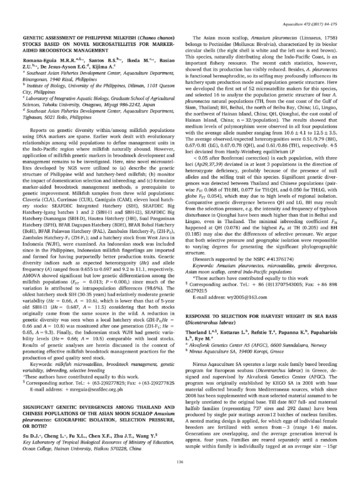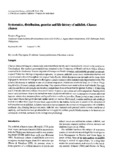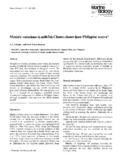| dc.contributor.author | Romana-Eguia, Maria Rowena R. | |
| dc.contributor.author | Santos, Brian S. | |
| dc.contributor.author | Ikeda, Minoru | |
| dc.contributor.author | Basiao, Zubaida U. | |
| dc.contributor.author | Kijima, Akihiro | |
| dc.date.accessioned | 2018-02-05T06:14:37Z | |
| dc.date.available | 2018-02-05T06:14:37Z | |
| dc.date.issued | 2018 | |
| dc.identifier.citation | Romana-Eguia, M. R. R., Santos, B. S., Ikeda, M., Basiao, Z. U., & Kijima, A. (2018). Genetic assessment of milkfish (Chanos chanos Forsskal) stocks based on novel short tandem repeats for marker-aided broodstock management. Aquaculture Research, 49(4), 1557-1568. | en |
| dc.identifier.issn | 1355-557X | |
| dc.identifier.uri | http://hdl.handle.net/10862/3251 | |
| dc.description.abstract | Milkfish hatchery broodstock are either from on-grown wild-caught or hatchery-produced fry/juveniles. To determine if a marker-assisted management scheme can be formulated for improved milkfish hatchery production, milkfish stocks were genetically characterized using nine novel short tandem repeats or microsatellites. Eight wild-bred Philippine stocks (CLA, CUR, CAM, SIH, SBH-I1, HH, PAL and ZH-P0), four hatchery-bred stocks (SBH-I2, SBH-D, BoH and ZH-F1), two farm stocks of known mixed lineages (SPH and BDH) and one Indonesian hatchery-bred stock (WJH) were assessed. WJH was included since milkfish fingerlings from Indonesia reared in Philippine farms could be developed into future broodstock. Mean allelic richness (Ar) was highest in wild-bred stocks (9.5) and lowest in hatchery-bred spawners (9.1). Mean expected heterozygosities (He) were relatively similar in all stocks with wild-bred stocks slightly higher (0.67) than the others. An analysis of molecular variance indicated significant yet low genetic differentiation among stocks (FST = 0.013; p = .000) where variation (98.6%) was explained by intra-stock differences. In some of the domesticated stocks, reductions in mean allelic richness were observed in first generation hatchery broodstock (e.g. ZH-F1; Ar = 8.3), compared with their founder stock (e.g. ZH-P0; Ar = 9.4). The Indonesian stock was similar to local wild-bred stocks based on genetic variability indices; thus, it might be likely that the local stocks’ fitness traits could be comparable with the imported milkfish stock which has been perceived to be better. The quality of locally available farmed milkfish and prospects of formulating a broodstock management scheme for the production of good quality milkfish seedstock are herewith discussed. | en |
| dc.language.iso | en | en |
| dc.publisher | John Wiley and Sons | en |
| dc.subject | Genetic monitoring | en |
| dc.subject | Marker-aided broodstock management | en |
| dc.subject | milkfish | en |
| dc.subject | Milkfish short tandem repeats | en |
| dc.subject | Chanos chanos | en |
| dc.title | Genetic assessment of milkfish (Chanos chanos Forsskal) stocks based on novel short tandem repeats for marker-aided broodstock management | en |
| dc.type | Article | en |
| dc.citation.volume | 49 | |
| dc.citation.issue | 4 | |
| dc.citation.spage | 1557 | |
| dc.citation.epage | 1568 | |
| dc.citation.journalTitle | Aquaculture Research | en |
| dc.subject.asfa | genetic variation | en |
| dc.subject.asfa | genetic variability | en |
| dc.subject.asfa | breeding stock | en |
| dc.identifier.essn | 1365-2109 | |
| dc.identifier.doi | 10.1111/are.13610 | |
| dc.subject.scientificName | Chanos chanos | |



